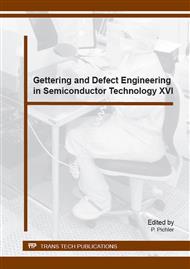[1]
L. T. Canham, Bioactive silicon structure fabrication through nanoetching techniques, Advanced Materials. Vol. 7, № 12 (1995) 1033-1037.
DOI: 10.1002/adma.19950071215
Google Scholar
[2]
E. Tasciotti, X. Liu, R. Bhavane, K. Plant, A.D. Leonard, B. K. Price, M. M. -C. Cheng, P. Decuzzi, J. M. Tour, F. Robertson, M. Ferrari, Mesoporous silicon particles as a multistage delivery system for imaging and therapeutic applications , Nature Nanotechnology. Vol. 3, № 3 (2008).
DOI: 10.1038/nnano.2008.34
Google Scholar
[3]
J. H. Selj, A. Thogersen, S. E. Foss, E. S. Marstein, Optimization of multilayer porous silicon antireflection coatings for silicon solar cells, Journal of Applied Physics. Vol. 107, № 7 (2010).
DOI: 10.1063/1.3353843
Google Scholar
[4]
R. Brendel, Thin-film crystalline silicon mini-modules using porous Si for layer transfer, Solar Energy. Vol. 77, № 6 (2004) 969-982.
DOI: 10.1016/j.solener.2004.08.011
Google Scholar
[5]
E. V. Astrova, Y. A. Zharova, V. P. Ulin, G. V. Enicheva, Anisotropy of porous silicon formation rate in p-Si, Physica Status Solidi a-Applications and Materials Science. Vol. 210, № 4 (2013) 723-727.
DOI: 10.1002/pssa.201200472
Google Scholar
[6]
E. V. Astrova, Y. A. Zharova, Wagon-wheel, mask as a tool to study anisotropy of porous silicon formation rate, Nanoscale Research Letters. Vol. 7 (2012) 1-8.
DOI: 10.1186/1556-276x-7-421
Google Scholar
[7]
E. V. Astrova, V. P. Ulin, Y. A. Zharova, I. L. Shul'pina, A. V. Nashchekin, Anisotropy Effects in Electrochemical Etching of p(+)-Si, Journal of the Electrochemical Society. Vol. 159, № 3 (2012) D172-D180.
DOI: 10.1149/2.095203jes
Google Scholar
[8]
M. Elwenspoek, H. V. Jansen, Silicon Micromachining, Cambridge University Press, Cambridge, (2004).
Google Scholar
[9]
M. I. J. Beale, J. D. Benjamin, M. J. Uren, N. G. Chew, A. G. Cullis, An experemental and theoretical-study of the formation and microstructure of porous silicon, J. of Crystal Growth. Vol. 73, № 3 (1985) 622-636.
DOI: 10.1016/0022-0248(85)90029-6
Google Scholar
[10]
F. Gaspard, A. Bsiesy, M. Ligeon, F. Muller, R. Herino, Charge-exchange mechanism responsible for p-type silicon dissolution during porous silicon formation, Journal of the Electrochemical Society, Vol. 136, № 10 (1989) 3043-3046.
DOI: 10.1149/1.2096399
Google Scholar
[11]
A. Halimaoui, Porous Silicon Formation by Anodization, in L. Canham, Properties of porous silicon, United Kingdom INSPEC, The Institution of Electrical Engineers, London, 1997, pp.12-23.
Google Scholar
[12]
V. P. Parkhutik, L. K. Glinenko, V. A. Labunov, kinetics and mechanism of porous layer growth during normal-type silicon anodization in HF solution, Surface Technology, Vol. 20, № 3 (1983) 265-277.
DOI: 10.1016/0376-4583(83)90009-2
Google Scholar
[13]
M. I. J. Beale, N. G. Chew, M. J. Uren, A. G. Cullis, J. D. Benjamin, Microstructure and formation mechinism of porous silicon, Applied Physics Letters, Vol. 46, № 1 (1985) 86-88.
DOI: 10.1063/1.95807
Google Scholar
[14]
R. Herino, G. Bomchil, K. Barla, C. Bertrand, J. L. Ginoux, porosity and pore-size distributions of porous silicon layers, Journal of the Electrochemical Society, Vol. 134, № 8A (1987) 1994-(2000).
DOI: 10.1149/1.2100805
Google Scholar
[15]
V. Lehmann, R. Stengl, A. Luigart, On the morphology and the electrochemical formation mechanism of mesoporous silicon, Materials Science and Engineering B-Solid State Materials for Advanced Technology, Vol. 69 (2000) 11-22.
DOI: 10.1016/s0921-5107(99)00286-x
Google Scholar


